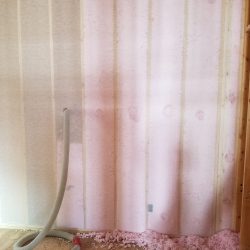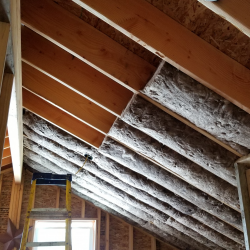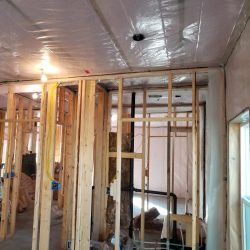BLOWN-IN FIBERGLASS
We specialize in blown-in fiberglass and we strongly recommend our vapor barrier services to protect your insulation, structure, and interior finish. We can do the following with blown in insulation:
- Dense Pack Walls
- Dense Pack Attics
- Loosefill Attics
- Dense Pack Floors
- Sound Proofing Interior Walls

BATT INSULATION
We highly recommend our blown fiberglass service over batts as we can give you better r-values and peace of mind.
However, blown fiberglass is not always within the budget and/or feasible for every project. We can install fiberglass batts and mineral wool batts.

VAPOR BARRIER
After we have insulated your project, we will install a 6 mil poly vapor barrier over your insulation and seal it up with a rubber-like vapor seal on all the edges and seams.
In addition to providing a vapor barrier on your exterior surfaces we can install vapor barrier on your crawlspace floor to keep odors out of your home and your crawlspace dry.

FREQUENTLY ASKED QUESTIONS
Q. What does R-Value Mean?
A. R-Value in a nutshell means “resistance to heat loss”. The higher the R-Value the better.
Q. Do you offer spray foam (urethane) services?
A. We will take on small spray foam details such as rim joists during the summer months when we can ensure the temperature is above 50 degrees. If the project is a whole home or shop please call Homer Foamer for spray foam services.
Q. Can you add insulation behind drywall or siding?
A. Typically, no. Either the drywall or the siding will have to come off first for us to properly do the job.
Q. Can you add insulation over top of our insulation in our attic?
A. In most cases, yes, as long as there is an area large enough for us to work in.
Q. Which is better? Fiberglass or cellulose?
A. They both are great insulators when installed properly. The major difference with cellulose is that is dustier, and less expensive as it is made from recycled paper. Both have fire, mold, and insect resistance. Cellulose will settle in attics and by following manufacturers installation requirements by blowing over the actual amount you want, we compensate for the settling to give you the R-Value you paid for. Fiberglass is much easier to work with from our experience, has less chances of failure, and thus is our first choice.
Q. Why choose blow in over batts? They offer similar R-Values?
A. No matter how good you install batts, and no matter the R-Value listed on the package, batting has many weaknesses as it does not entirely fill the cavity and in attics there is more stud loss as it does not cover the trusses on the attic side. Blown in completely fills the wall cavity and is blown over top of trusses in the attic, meaning less heat loss through the studs. In addition the batting can be inconsistent in thickness as it comes out of the package, thus resulting in inconsistent rvalues for a given space.
Q. Do you take credit cards as payment?
A. Yes, but we will have to add a 3% processing fee to the invoice.
